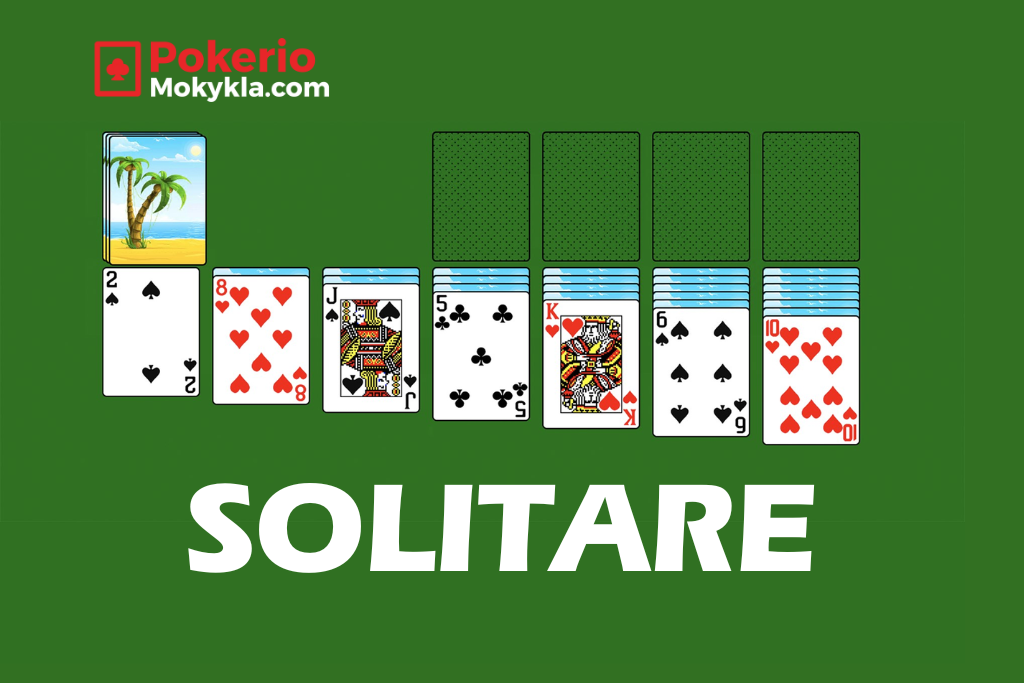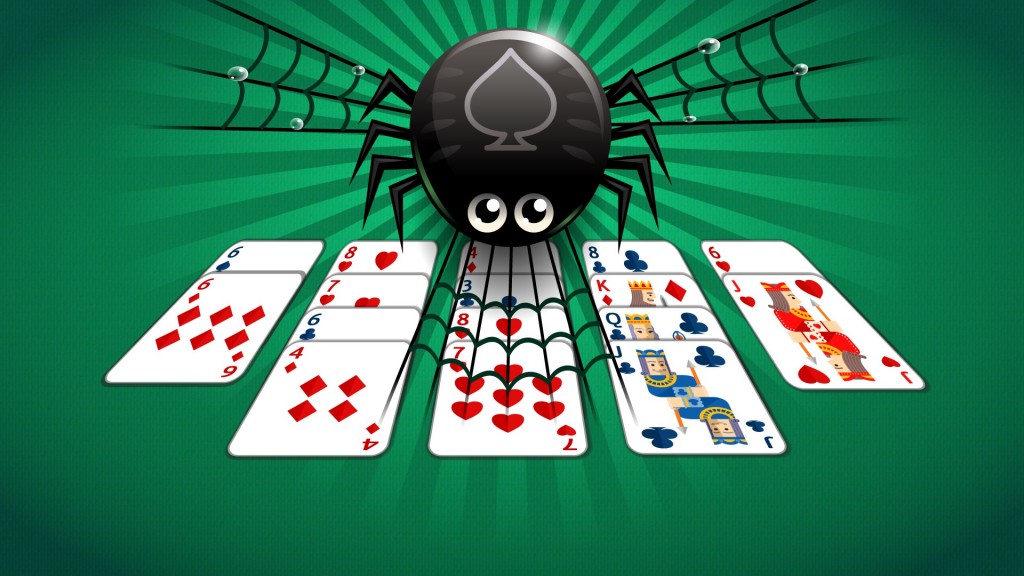Solitaire Card Game
Solitaire (French Patience), also known as solitaire (English Solitaire) – an interesting game where the goal is to sort the cards according to certain rules, for example, by suit or hierarchy.
Today, solitaire games are played all over the world, and there are over one and a half thousand known variations.
Solitaire Online:
Types and Rules of Solitaire
“Traditional, or Klondike Solitaire”
This game variant was made famous by computer solitaire versions. Interestingly, most people know this version of solitaire but don't even know its real name!
The probability of winning is very low – just one in thirty. It's tough, but worth a try!
Card Layout
Played with a deck of 52 cards. The deck is shuffled and 7 piles of cards are laid out – the first pile has 1 face-up card, the second pile has 1 face-up and 1 face-down card, the third pile has 1 face-up and 2 face-down cards, and so on.
It's important that only 1 card is face-up. During the game, four empty fields must be prepared.
Game Objective
Move all the cards to the four fields, starting with the ace and ending with the king – A, 2, 3, 4, 5, and so on.
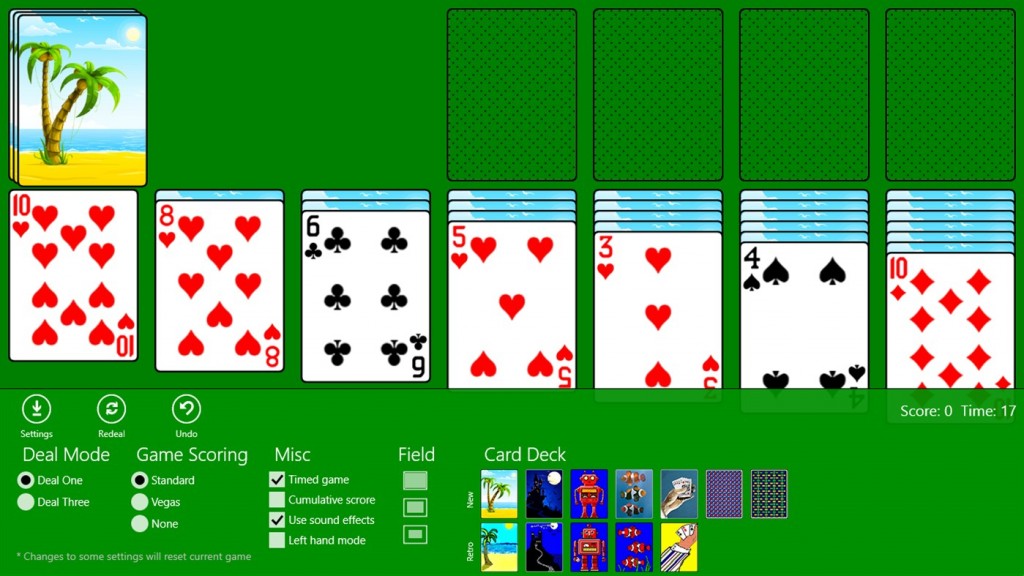
How to Play?
If the first face-up cards are aces, they can be placed in the empty fields immediately. Then look for twos. If there are none – you can draw cards from the main deck or place cards on top of each other from the seven piles.
On each card, you can place a card that is one rank lower (for example, a five on a six or a queen on a king), aiming to uncover as many face-down cards as possible.
If this cannot be done, the player must draw a new card from the main deck and place it either on the 7 piles or in one of the 4 fields.
Cards from the reserve can be taken three at a time. Cards taken from the reserve but not used go back to the reserve, flipped over, and placed at the bottom.
“Scorpion Solitaire”
It is said that this variant is a real challenge for solitaire enthusiasts, as the chances of winning are no more than 1 in 10.
Card Layout
Played with a deck of 52 cards. 49 cards are laid out in 7 columns of 7 cards each, so that the cards in the three rightmost columns are face-up, and the cards in the four leftmost columns are face-up only for the top 4 cards in each.
The remaining 3 cards stay in the deck – the reserve.
Game Objective
Arrange the cards by suit in descending order from king to ace – K, Q, J, 10, 9, and so on.
How to Play?
There is no special field for moving cards in this solitaire variant. Cards are sorted by moving them from one column to another. Cards can be flipped one at a time (if it is at the top of the column) or in parts of the column or even the entire column.
The most important thing is that the moved card or the last card of the moved column is of the same suit as the one it is placed on, but the latter must be one rank higher, for example, a five of hearts can only be placed on a seven of hearts.
The face-down card left at the bottom of the moved column must be flipped. When all the cards in a column are taken, any card or sequence of cards can be moved to its place.
When there are no more cards to move, one face-up card from the remaining 3-card deck – the reserve – can be placed on each of the three leftmost columns.
“Spider Solitaire”
This game variant is very similar to the usual solitaire variant, but it is longer and more complicated.
Card Layout
Played with two decks of 52 cards. The cards are carefully shuffled and laid out in 10 columns – 8 columns will have 5 cards each, and 2 will have 6 cards each.
The first cards of the piles must be face-up, all others face-down. Place the other deck to the left – it will be used for card replenishment, and leave 8 empty fields above the ten piles for the card suits.
Game Objective
Arrange the cards by suit and rank into piles from ace to king.
In total, you should arrange 8 piles of cards – 2 hearts, 2 diamonds, 2 clubs, and 2 spades.
How to Play?
Cards can be placed on top of each other regardless of their suit – only the rank of the cards matters.
A lower-ranked card is placed only on a higher-ranked card. Cards can be placed in columns, trying to uncover as many face-down cards as possible. Later, sort the cards by color, and place the collected suit in a free column.
If there are no more options to move cards, place one card from the additional deck on each column. Note – you cannot leave an empty column until all the cards from the additional deck are dealt.
The game is won by correctly arranging all 8 suits.
“Golf Solitaire”
This solitaire's name comes from the game of golf, where the main rule is to score as few points as possible. The main nuance of this solitaire is that only a card of one rank higher or lower can be placed on top of another.
This type of game is not very complicated but is perfect for those who enjoy challenges, logical, and strategic thinking players.
Card Layout
Played with a deck of 52 cards. 35 cards are laid out in 7 columns of 5 cards each. The cards must be face-up and slightly overlap each other so that the card placed can still be seen.
All other remaining cards are placed separately, and the top card of this reserve is turned over.
Game Objective
Collect the laid-out cards on the flipped reserve card.
How to Play?
You can place any card that is one rank higher or lower on the flipped card, regardless of its suit.
You can only choose the card to be placed on the reserve card from the 7 uncovered cards. If none of them fit, place the top flipped card from the reserve pile on the collecting pile and look for a suitable one again.
The game is lost when there are no more possibilities to move any puzzle cards and the reserve is fully used. The game is won when all covered cards are laid out (excluding reserve cards).
If you want to make the game harder, come up with special rules, for example, place only a two on an ace, and only a queen on a king.
You can also count points, which are awarded for each puzzle card not moved. If the puzzle cards are laid out, you get a negative point for each card taken from the reserve. Two players can play by counting points.
In this case, 9 rounds are played, and their points are summed up. The goal is to collect no more than 4 points per round and the final score should not exceed 36 points.
“Yukon”
This is sometimes called the cousin of traditional solitaire due to its similar layout and slight rule differences.
Card Layout
Played with a deck of 52 cards. 28 cards are laid out in columns of 7. The first column consists of 1 card, the second of 2, the third of 3, and so on.
The first cards of the piles are flipped, and the remaining cards slightly cover each other. Then, the remaining 24 cards are laid out on these piles, except for the first column. Thus, the first column will have 1 card, and all others will have 5 each.
Game Objective
Arrange the cards by hierarchy and suits from ace to king – A, 2, 3, 4, 5, and so on.
How to Play?
Only the first flipped cards of the piles can be placed in the 4 free suit spaces. If an ace appears, immediately move it to a free space and continue looking for higher-ranked cards to place on the ace.
In the game field, in the columns, arrange the cards in descending order – place a nine on a ten, an eight on a nine, and so on. You can also alternate colors – place a black card on a red one.
In this variant, you can move any flipped card, even if there are other cards on it. For example, on a free flipped card that is a queen of hearts, you can place a jack of spades, even if there is a three or two on it. If a face-down card remains at the top of the column, it must be flipped.
When all the cards in a column are taken, only a king can be placed in that column's space – either alone or with the cards on it.
“Canfield”
Canfield, also known as Demon Solitaire, is a mysterious and interesting game variant. Legend has it that the owner of the Canfield casino challenged solitaire players.
He sold a deck of cards for $50 and paid $5 for each solitaire completed by the player!
This is interesting because the suits are arranged by hierarchy, but the first card on which they are placed is random.
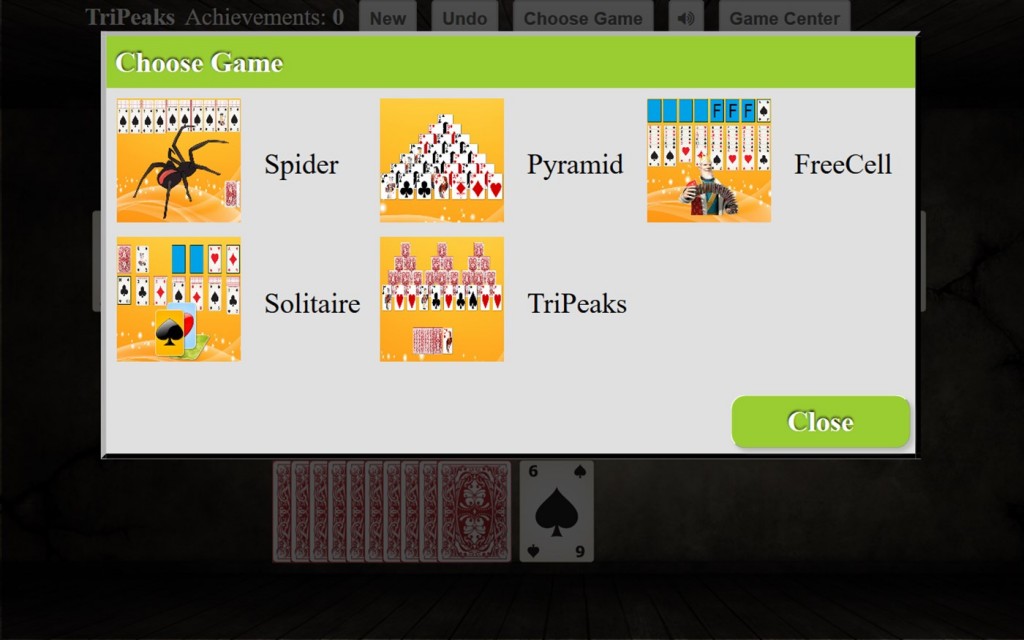
Card Layout
Played with a deck of 52 cards. 13 cards are set aside in a separate pile, with the top one flipped. This card needs to be placed in a separate space for card stacks.
This card becomes the one on which other cards will be placed. The first cards of the other three suits must be of the same rank, but they can only be placed after the game starts. Below the first flipped card, lay out 4 more flipped cards from the 13-card reserve.
All remaining cards form the main reserve. Flip 3 more cards from the main reserve.
Game Objective
Collect the first base cards of the other three suits and place all the cards of that suit in order by rank on each such card. For example, if the first flipped card is a five, the cards will be arranged as follows – 5, 6, 7, 8, 9, 10, Q, K, A, 2, 3, 4.
How to Play?
Only the top reserve cards and free game cards can be moved – they are placed in the free 4 suit spaces or on top of each other. In the game field, cards are arranged in descending order, and colors can be alternated.
Cards can also be arranged in columns. If a free space appears in the game field, place a card from the 13-card reserve in it. If this reserve is already used, place a card from the main reserve.
Cards from the 13-card reserve are taken one at a time, and from the other reserve three at a time. Unsuitable cards are placed back at the bottom of the reserve and used again later. The game continues until all four suit cards are arranged or when there are no more possibilities to move cards.
“Eastheaven”
This solitaire variant is of medium difficulty, with a winning probability of 1 in 10.
Card Layout
Played with a deck of 52 cards. The cards are laid out in 7 columns of 3. The bottom cards of the columns are flipped. Also, leave 4 spaces where the cards will be placed. The remaining cards are placed in the reserve, which will also be needed.
Game Objective
Arrange the cards by hierarchy and suits from ace to king – A, 2, 3, 4, 5, and so on.
How to Play?
Move any first card of the 7 columns onto another card if it is of a lower rank and a different suit. If the first card is an ace, immediately place it in the stack space. Continue placing all other cards of that suit in ascending order on it.
If you approach a face-down card, flip it, and if there are no cards left in the game field that can be moved, remove 7 cards from the remaining pile and lay them out flipped on top of the column's top cards.
Note – do not take cards from the reserve while there are still possible moves, and try to flip as many face-down cards as possible. Cards can also be moved in columns. When all the cards in a column are moved elsewhere, a king can be placed in its free space.
“Pyramid Solitaire”
This, also known as Triangle or Thirteen. The game is based on calculating card values – when arranging the pyramid, you need to form pairs of cards so that their combined values equal 13 points.
It is said that this solitaire is easy to learn, but the game itself can take time!
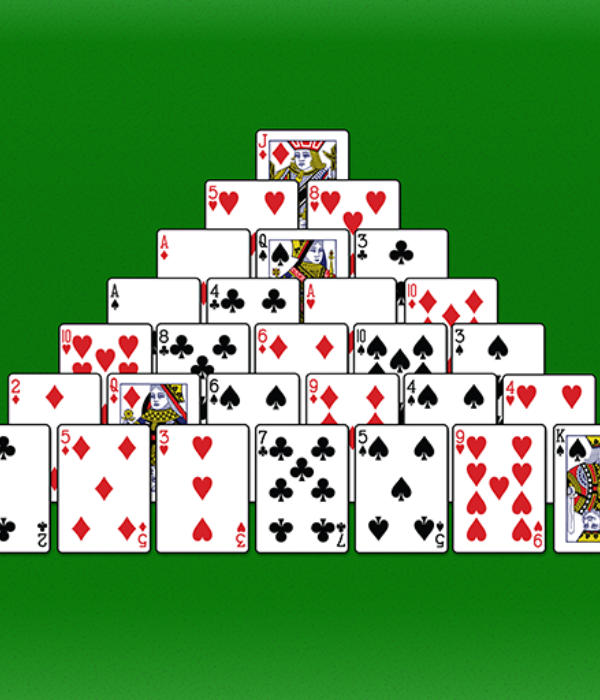
Card Layout
Played with a deck of 52 cards. 28 cards are arranged in a triangle with 7 rows – the top row has 1 face-up card, the second row has 2 cards, the third row has 3, and so on.
Cards should be placed from top to bottom so that the lower rows cover the higher ones. Place the remaining cards in a separate pile on the left, as you will place discarded cards on the right side.
Game Objective
Collect the entire deck by discarding cards from the pyramid and the remaining deck that have a combined value of 13 points.
How to Play?
First, remember the card values. Number cards have as many points as their number (ace is valued at 1), while face cards are more valuable. Jack is worth 11 points, queen – 12, king – 13. Discard cards from the playing field and the reserve in pairs or singly (only the king), but the total value of the discarded cards must equal 13 points.
Possible combinations of discarded cards – king; queen and ace; jack and two, ten and three; four and nine; five and eight; six and seven.
“Three Towers”
This is perhaps the fastest and shortest solitaire variant, resembling Pyramid in layout and Golf in rules.
Card Layout
Played with a deck of 52 cards. 28 face-up cards are arranged in 3 different pyramids in rows from top to bottom – place 3 cards in the top row at a distance, 2 cards in the second row covering the top cards (a total of 6), 3 cards in the third row covering the second row cards (a total of 9), and 10 cards side by side in the last row.
All remaining cards form the reserve, with the first card turned face up and placed next to it.
Game Objective
Collect all the cards laid out in the playing field onto the first reserve card.
How to Play?
On the first reserve card, you can place any card that is one rank lower or higher – suit and color do not matter. You can only collect cards from uncovered cards, and if none of them fit, place the top reserve card on the collected cards pile and then look for a suitable card for it.
The game is won by collecting all the cards laid out in the playing field, regardless of whether any remain in the reserve.
“FreeCell Solitaire”
A game requiring skill and clear strategy, which will make even the biggest game skeptics try to arrange the cards.
Moreover, the probability of winning is 99%. Of course, only if you create a flawless strategy!
Card Layout
Played with a deck of 52 cards. The playing area is divided into 3 fields – a field for family piles, a playing field, and a spare field where cards can be regrouped.
Allocate enough space for the spare and family piles fields to fit 4 cards side by side.
In the playing field, arrange face-up cards in 8 columns – 7 cards in the first 4 columns, and 6 cards in the remaining columns. Cards should cover each other.
Game Objective
Arrange the cards in families according to hierarchy from ace to king – A, 2, 3, 4, and so on.
How to Play?
As in other solitaire games, you can only move the first face-up cards of the piles, but only one at a time. You can move cards to the spare or family fields and onto other first pile cards. Cards are arranged in descending order – jack is placed on the queen.
Additionally, colors must alternate – a red card is placed on a black card, and a black card on a red card. Aces, as in regular solitaire games, are immediately placed in their designated spot, and then cards are sought in descending order.
You can move a card to the spare field only if there is space – remember, there is space for only 4 cards. Cards are kept here temporarily and used only when needed in the playing field or when there is an opportunity to place them in the family piles.
“Bahama Cards”
This is another solitaire variant that can also be played online.
Card Layout
Played with a deck of 52 cards. Cards are arranged into 3 piles – the middle pile is arranged in a triangle of 10 cards – 1 card at the top, 2 in the second row, and so on. The fourth row cards should be face-up, and all others face-down. Additionally, 5 cards are arranged on the left and right sides of the triangle.
One card from the 5 in these piles should be face-up.
The remaining deck cards are set aside in the reserve, with the first card turned face up.
Game Objective
Arrange all the cards in the playing field into the card stack at the bottom.
How to Play?
On the first reserve card, place a card that is one rank lower or higher – suit and family do not matter. You can only arrange free, face-up cards. Face-down cards can be turned face-up only when the cards covering them are removed.
If there are no more options, take another card from the reserve, place it on top, and now look for a card one rank lower or higher for this card.
A Brief History of Solitaire
In the 18th century, Solitaire, also known as Patience, appeared in Northern Europe. At that time, it became very popular among French nobility.
In the 19th century, this game spread throughout Europe, and important publications such as Lady Adelaide Cadogan's “Illustrated Games of Patience” in 1870 helped standardize the rules. Various versions emerged at that time, such as Klondike and Spider.
In the 20th century, Solitaire became even more popular.
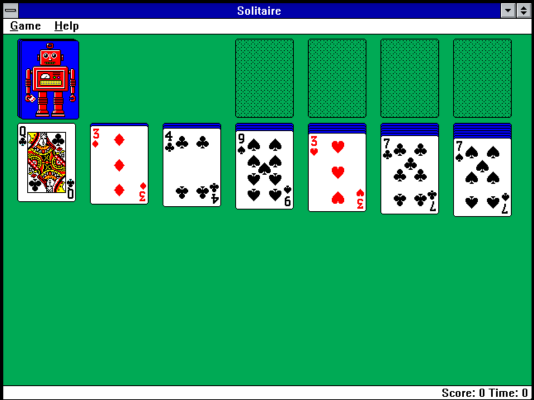
The digital version was added in 1990 with “Microsoft Windows 3.0,” making the game easy to play for people worldwide.
Today, thanks to the internet and mobile phones, solitaire remains a beloved game worldwide. People enjoy it because it is simple and has many different ways to play.
Find more card games here.




